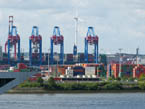Overview of Maritime Logistics
Maritime logistics refers to the process of managing the movement of goods and products through sea transport. It involves coordinating various stakeholders, including shipping companies, ports, and logistics providers, to ensure the efficient and cost-effective transit of goods. The goal of maritime logistics is to minimize costs, reduce delivery times, and optimize resource utilization while adhering to international regulations and safety standards.
The shipping process begins with cargo preparation, including packaging and labeling, followed by loading onto ships at the origin port. Once loaded, the vessel travels to the destination port, where the goods are unloaded and transferred to ground transportation or stored until demand. Advanced technologies such as tracking systems, real-time monitoring, and digital documentation are widely used to enhance transparency and efficiency in the process.
Maritime logistics plays a crucial role in the global supply chain, enabling businesses to meet customer demands while maintaining competitive pricing. However, challenges such as weather conditions, port congestion, and customs clearance can impact delivery times and costs. Despite these challenges, advancements in technology and collaboration among stakeholders continue to drive innovation in the field.
Conclusion
Maritime logistics is a vital component of global trade, ensuring the seamless movement of goods across oceans. By leveraging technology and efficient processes, businesses can optimize their supply chain operations and deliver value to customers. As the industry evolves, further investment in innovation and collaboration will be key to maintaining a competitive edge.
